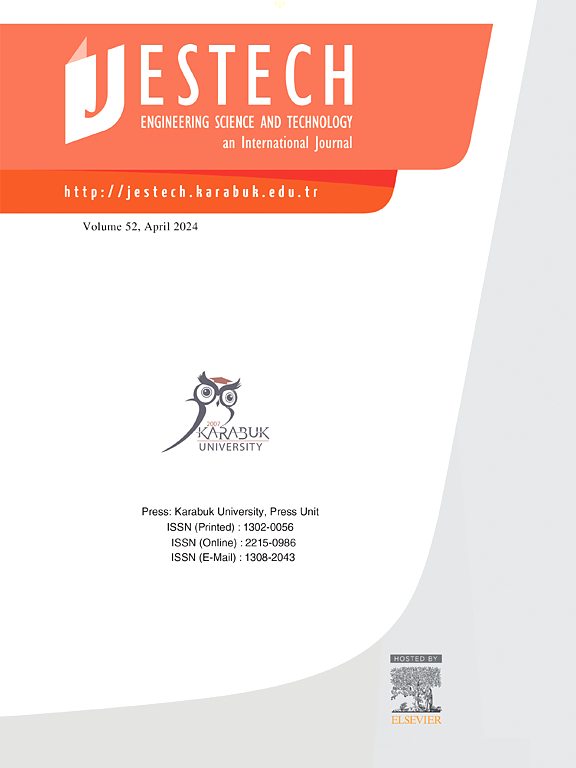Time–frequency ensemble network for wind turbine mechanical fault diagnosis
IF 5.1
2区 工程技术
Q1 ENGINEERING, MULTIDISCIPLINARY
Engineering Science and Technology-An International Journal-Jestech
Pub Date : 2025-04-08
DOI:10.1016/j.jestch.2025.102056
引用次数: 0
Abstract
Wind turbines typically operate under variable speed conditions, so the collected vibration signals are affected by non-linearity and information mixing, while also containing a large amount of noise interference. However, most existing methods extract fault features from a single domain, failing to capture the signals’ diverse and complex characteristics. To fully exploit multi-domain discriminative features under variable speed conditions, this paper proposes a time–frequency ensemble network (TFNet). First, the feature representation is improved by constructing an adaptive spectral block (ASB) using Fourier analysis, while an adaptive threshold is introduced to reduce noise interference. Second, the Transformer and Graph Convolutional Network (GCN) are combined to extract the time–frequency discriminative features of defects. Specifically. In the time domain module, the global time domain features of faults are extracted by the Transformer encoder block. In the frequency domain module, a mixhop graph convolutional network is used to extract the multi-scale frequency domain features of different neighbours, and a Multi Head Attention (MHA) mechanism is introduced to capture the intra-feature dependencies. To achieve better diagnostic results under variable speed conditions, a label smoothing algorithm is used to assist the training of the model. A case study is conducted using the WT-Planetary gearbox dataset and the XJTUSuprgear variable speed gearbox dataset as well as the CWRU Bearing dataset. The experimental results show that the proposed model has high diagnostic accuracy and strong generalisation ability compared to other fault diagnosis models.
风电机组机械故障诊断的时频集成网络
风力机通常在变速工况下运行,因此采集到的振动信号受到非线性和信息混合的影响,同时还包含大量的噪声干扰。然而,现有的故障特征提取方法大多是单一域的,无法捕捉到信号的多样性和复杂性。为了充分利用变速条件下的多域判别特征,提出了一种时频集成网络(TFNet)。首先,利用傅里叶分析构造自适应谱块(ASB)来改进特征表示,同时引入自适应阈值来降低噪声干扰;其次,结合变压器和图卷积网络(GCN)提取缺陷的时频判别特征;特别。在时域模块中,通过Transformer编码器块提取故障的全局时域特征。在频域模块中,使用mixhop图卷积网络提取不同邻居的多尺度频域特征,并引入多头注意(Multi - Head Attention, MHA)机制捕获特征间的依赖关系。为了在变速条件下获得更好的诊断结果,采用标签平滑算法辅助模型的训练。以wt -行星齿轮箱数据集、xjtusupgear变速齿轮箱数据集和CWRU轴承数据集为例进行了研究。实验结果表明,与其他故障诊断模型相比,该模型具有较高的诊断准确率和较强的泛化能力。
本文章由计算机程序翻译,如有差异,请以英文原文为准。
求助全文
约1分钟内获得全文
求助全文
来源期刊

Engineering Science and Technology-An International Journal-Jestech
Materials Science-Electronic, Optical and Magnetic Materials
CiteScore
11.20
自引率
3.50%
发文量
153
审稿时长
22 days
期刊介绍:
Engineering Science and Technology, an International Journal (JESTECH) (formerly Technology), a peer-reviewed quarterly engineering journal, publishes both theoretical and experimental high quality papers of permanent interest, not previously published in journals, in the field of engineering and applied science which aims to promote the theory and practice of technology and engineering. In addition to peer-reviewed original research papers, the Editorial Board welcomes original research reports, state-of-the-art reviews and communications in the broadly defined field of engineering science and technology.
The scope of JESTECH includes a wide spectrum of subjects including:
-Electrical/Electronics and Computer Engineering (Biomedical Engineering and Instrumentation; Coding, Cryptography, and Information Protection; Communications, Networks, Mobile Computing and Distributed Systems; Compilers and Operating Systems; Computer Architecture, Parallel Processing, and Dependability; Computer Vision and Robotics; Control Theory; Electromagnetic Waves, Microwave Techniques and Antennas; Embedded Systems; Integrated Circuits, VLSI Design, Testing, and CAD; Microelectromechanical Systems; Microelectronics, and Electronic Devices and Circuits; Power, Energy and Energy Conversion Systems; Signal, Image, and Speech Processing)
-Mechanical and Civil Engineering (Automotive Technologies; Biomechanics; Construction Materials; Design and Manufacturing; Dynamics and Control; Energy Generation, Utilization, Conversion, and Storage; Fluid Mechanics and Hydraulics; Heat and Mass Transfer; Micro-Nano Sciences; Renewable and Sustainable Energy Technologies; Robotics and Mechatronics; Solid Mechanics and Structure; Thermal Sciences)
-Metallurgical and Materials Engineering (Advanced Materials Science; Biomaterials; Ceramic and Inorgnanic Materials; Electronic-Magnetic Materials; Energy and Environment; Materials Characterizastion; Metallurgy; Polymers and Nanocomposites)
 求助内容:
求助内容: 应助结果提醒方式:
应助结果提醒方式:


